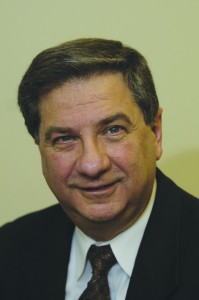
In his 25 years as president of the Healthcare Association of New York State, Dan Sisto said he has never seen a health care situation “as fragile as the one we are now facing.”
One economically protective splint may be on the way, however, by treating health woes as “episodes of care” to be bundled for billing rather than charging piecemeal.
Sisto said the association (HANYS) had already created a Medicaid task force before the November elections. “We had a 40 page report, and much of it was incorporated into the Medicaid redesign team”™s initiatives. We just had our first organized meeting and got an overview of what the MRT is doing.”
Sisto cited edgy times, noting, “There is a great deal of anxiety and fear hitting our hospitals, the result of the Affordable Care Act requirements as well as the debt crisis ongoing in Washington. The potential loss of income is devastating.”
Sisto used Montefiore Medical Center in the north Bronx as just one example: “We are projecting a loss of nearly $1 billion over the next 10 years if the Medicare cuts discussed in Washington go through; the loss for each hospital in the state will be proportionate to its size.”
Sisto said the aging population and expansion of the Medicaid and Medicare programs the federal government is proposing translates to a $2 cost to private business for every $1 spent on the programs. “In fact, in New York today, the average Medicaid loss is 25 percent of the cost of the care. If a hospital is breaking even, but is losing 25 percent of its reimbursement, someone is paying for that loss, and it”™s usually the privately insured.”
The Medicaid Redesign Team”™s challenges are daunting, said Sisto. “It is focused on changing our entire system to streamline the health care system to save money and at the same time to comply with the new federal health care act.”
That change is going to be difficult and costly, said HANYS”™ president. “We are looking to move away from a volume-driven, fee-for-service system to one based on payment for an entire ”˜episode”™ of care, which includes the hospital, the doctor, the rehab center, the home health aide. A fee would be set and then the financial arrangements worked out to bundle payments. Right now, everyone is working piecemeal. It is a massive conceptual change on the way care is delivered and paid for.”
By the end of 2011, said Sisto, the MRT will have several recommendations: “Administrative actions, perhaps some regulatory relief, as well as legislative action. We going to have to find ways to bring in the capital to finance this change ”“ perhaps asking the federal government for a waiver so New York can initiate these changes along with some upfront financial support to achieve a more efficient, value-driven system.”
It may also mean more hospital closings, added Sisto. “If we are helped to invest in these reforms, we will be able to share the savings later. Money can come from making health care more efficient; but just as in private business, if you want to become more efficient, you have to invest in your business. We need the capital to invest in the changes the federal government is expecting us to achieve.”
Sisto said the Affordable Care Act may be scaled back. “At some point, this country is going to need a real budget, but I am worried the federal government may simply say, ”˜We don”™t have any more money to insure more people, but we will continue to cut providers”™ reimbursements.”™”
Sisto doubts New York can convince the federal government to take over its Medicaid program. “It”™s been here too long and is too ingrained, but the state is going to assume many of the functions currently performed by local Department of Social Service workers. There are some case management systems that need boots on the ground. It can be state workers doing this, which may result in the state picking up some of the expense counties are now paying,” said Sisto.















